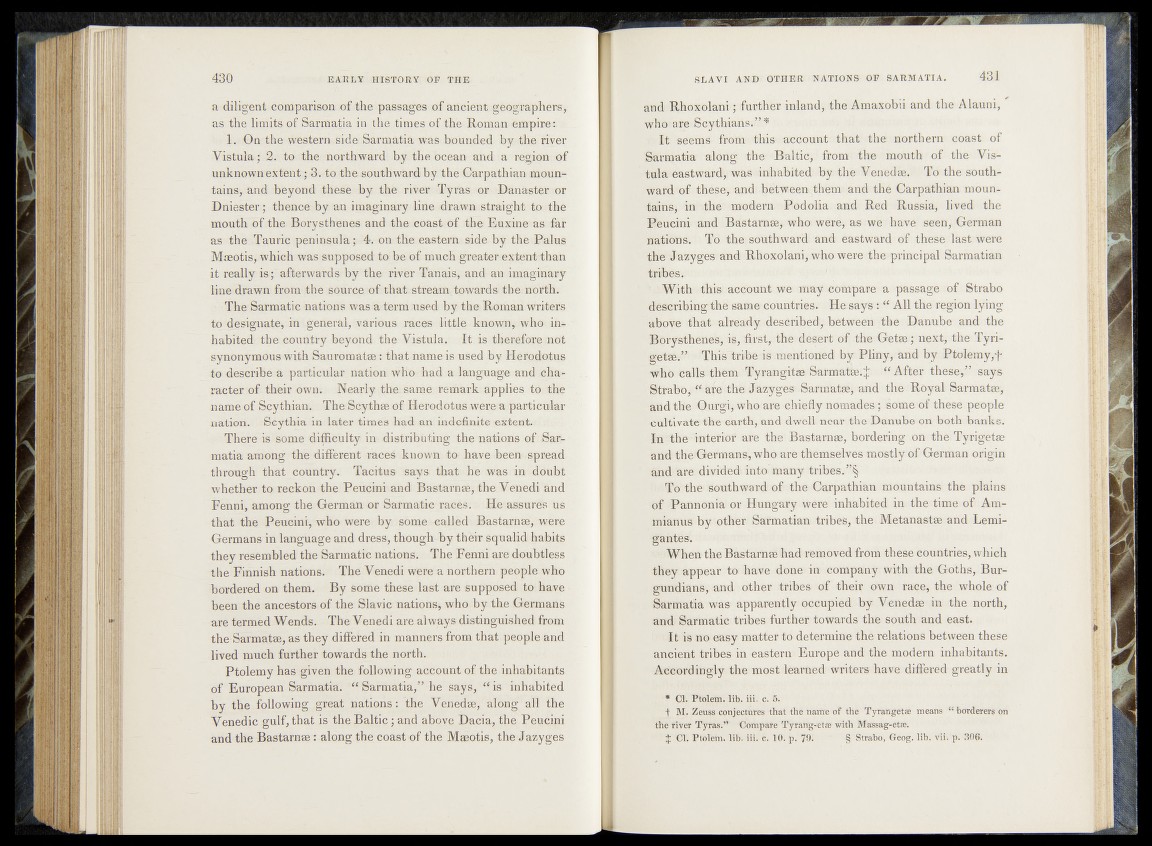
a diligent jcomparison of the passages of ajacienfeigeogmapheiTSy
as the limits of Sarmatia in the,times, of the-Roman empire;, te
1 . On the western side* Sarmatia was bounded b y the river
Vis tula ƒ 3 . to the northward by. the Ocean- and- a regiont of
unknown e x t e n t 3.-to the southward by the Carpathian ttiaun-
tains,artd beyond these by the river>TyrasQrDanaster;or
Dniester; theneeaby an imaginary dine «draw» straight tps the
mouth of the Borystbenes and the coast of the Baxitte'msTar
as the Tauric peninsula ; 4. on the eastern side by the PaluS
Mseotis, which was supposed to be of much greatenexterrHhan
it really is f afterwards by the river Tanaisr and an imaginary
line drawn from the source of that, stream, tovvards- the north.
The Sarmatic nations was aterm used) by tho Roman writers
to designate, in general, various races little hnown, wh»< in-
habited the country beyond the-Vistula. It» astherfiftajeuiot
synonymous with Sauroroat®: that name is used by Herodotus
to describe a particular nation who^had ,a. language and ,4har
racter of their own. Nearly the same remark applied ,t®s the
name of Scythian. The Scyth® of H ereto tuswerera particular
nation. : Scythia in later times had an; mdefiiMtie j^tenbBi|
There is some difficulty in distributing the nations ©T
matia among the different races known to have been.spread
through that country. Tacitus says- that he was in doubt
whether to reckon the Peucini and Bastarn®, the Venedi Und
Fenni. among the German or Sarmatic races, lie assures us
that the Peucini, who were by some called Bastarn®, were
Germans in language and dress, though by their squalid habits
they resembled the Sarmatic nations. The Fenni are doubtless
the Finnish nations. The Venedi were a northern people who
bordered on them. By some these last are supposed to have
been the ancestors of the Slavic nations, who by the Germans
are termed Wends. The Venedi are alw_ays distinguished from
the Sarmat®, as they differed in manners from that people and
lived much further towards the north.
Ptolemy has given the following account of the inhabitants
of European Sarmatia. “ Sarmatia,” he says, “ is inhabited
by the following great nations; the Vened®, aIoh^rapl the
Venedic gnlf, that is the Baltic; and above Dacia, the Peucini
and the Bastarn®: along the coast of the M®otis, the Jazyges
and Rhoxolani; and the Alauni,
who;areiScythiaiis.”’i •
It ''teems*- from this- account that the northern coast of
Sarmatia along ".the Baltic?),) from the motorh of the Vistula
IU m P P H To the south*
ward of • thesez,v?and bfetween^thenn .and the Carpathian mountains,
in th e modern Podolia and Red Russia, lived the
Peucini and BaStarn®,- who wbtej as;weahfave seeny'German
nations. To the^ southward and eastward of thesfe last were
the JuzygeS’ and
tribes; .
1 'W ith this account we may compare a-»passage-1 of Strabo
d escribing the sam o countries. He -All t£te regionl>yiiiS||
above that already »described,».between the-Danube and the
BorystherieS, is, hist, the dfiSerfe of the» Get®»; * next, the Tyri-
getaS.” This^tribeis .mentioned by Pliny^and by Ptolemy
who balls them Tyraoigit® S a r m a t ® . A f t e r t'h-eSe^” ^ay&
#tfabO, “ Ure the Jazyges* SarmUt®^ arid the »Royal Sarmat®,
arid the Glurgt, who’are»Chiefly nomade&4 some of these people
cultivate the earth, and. dwell near the Danube on both banks.
In the dnteriof are the: B astarnaip bordering o n th e Tyriget®
and thefGermans, wh o are thteriisfdvtejmostlyollGattman; origin
and are divi'ded into many? trihdS'/(i^v»
[ ^ToNfe? Southward of the Carpathian mountains the plains
b f Pannonia or Hungary were inhabited i® tlb®? time o f Ante*
miatius by other Sarmatian tribes, the -Metanast® and Lemi-
gantest ;;
I When the Bastartttehad removed from these countries,which
they appear to have donej in company? w ith th e Goths, Burgundians,
and other tribes of their race, the whole of
Sarmatia was apparently' occupied by Vened® in the north,
and Sarmatic tribes further towards theisouth and east.
It is no easy matter fb determine the relations between these
ancient tribes in eastern/ Europe and the modern inhabitants.
Accord ingly the most learned writer» have differed greatly in
" Cl. Ptolem. lit)., ili. o. 5.
M. Zeu^s cottjectifffes that tfi£ iiattre of fife Tyr&togetae meajis “ borderers On
the fiver Tyras.” ’Compare Tyrairg-etcfe' -With Masssag-etse.
$ ‘CT. Ptolem. lib. iii. c. 101 79* -r> § Strabo, Geog. lib. vii. p. 39®.